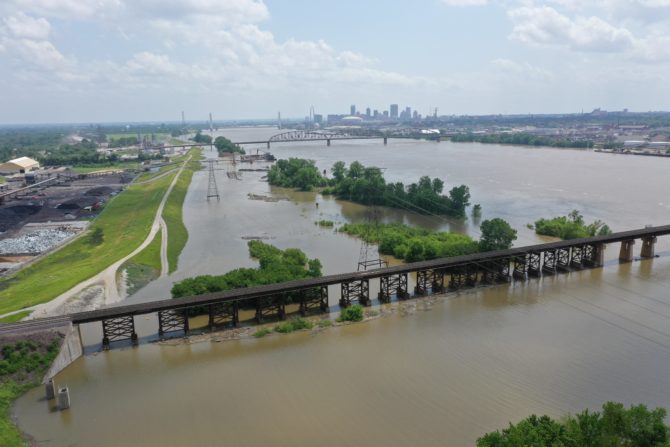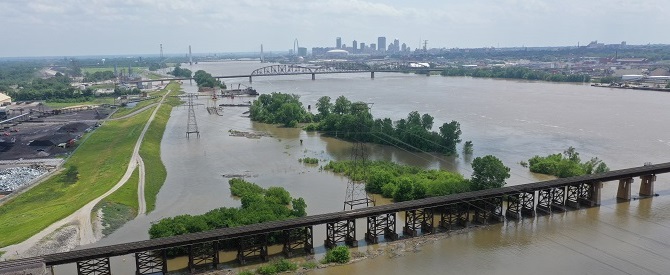Editor’s note: This article is the second in a three-part series about disruptions to base oil traffic on rivers in the Midwest, South and Eastern United States.
In 1883 Mark Twain wrote about the untamable nature of the Mississippi River, declaring that 10,000 river commissions, armed with all of the world’s explosives, “cannot curb it or confine it … cannot save a shore which it has sentenced; cannot bar its path with an obstruction which it will not tear down, dance over, and laugh at.”
Thirteen decades later, the Mississippi and other major U.S. rivers ways are still causing havoc for people dwelling along their courses as well as well as those using it for transportation of a wide range of goods, including base oils. In fact, although engineering has allowed some reduction in flooding since Twain’s day, susceptibility to disruptions is now rising again.
As flooding season approaches, base oil companies are preparing contingency plans and taking protective measures that range from technologically advanced high water warnings to low-tech monitoring of weather forecasts.
According to the U.S. Army Corp of Engineers, 2.3 billion tons of domestic and foreign cargo valued at $2 trillion moves on U.S. waterways each year. Of that, approximately 22 percent is petroleum products, including base oils, and another 10 percent is chemicals, including lubricant additives, based on 2017 findings by the Waterway Council Inc.
For Midwestern, Southern and Eastern suppliers and users of base oils, the potential for flooding is never far from their minds. “Flooding can delay deliveries weeks or even months,” said one industry source, who went on to note that deliveries by rail and truck can also be affected.
Flooding disrupts barge traffic in a few ways. High waters and excessive flow rates alter currents and the topography of the river and can make it dangerous to travel. They can also hinder the operation of locks that are crucial to vessels moving up and down many rivers – or render them temporarily unusable. Impacts vary from river to river and of course on the extent of flooding, but when water levels rise, disruptions are very possible.
“It is difficult to prevent future flooding if the water is already in the river,” said Lisa Parker, a spokesperson for the Corps of Engineers.
Last year, when the Illinois River flooded, the Chicago Board of Trade declared force majeure conditions. Then barge operator ACBL declared force majeure on Ohio River cargoes. “One issue we had recently was with problems along the Ohio River with some of the locks,” said another source, who asked not to be identified because of the effects on his company.
An average of 52 service interruptions happen per day on the inland waterways, the Corps estimates.
The potential for disruption of locks is amplified by the age of facilities, sources said. The Corps of Engineers and the Waterway Council estimate more than 60 percent of operational lock chambers are half a century or older, and more than 40 lock chambers in operations are 80 years or older. Base oil industry insiders said it is not unusual for a barge to sit for days, waiting to pass through a lock at times when the river is otherwise navigable. Such delays increase expenses for manpower and fuel used in delivery.
“One of the Corps’ greatest challenges is the aging infrastructure of all of our locks and dams,” Parker said.
Partly because of aging infrastructure, flooding on U.S. rivers is a worsening trend. The Corps of Engineers advises that $13 billion in cumulative investments will be needed this year to maintain existing levels of delays. Current funding levels can support only $7 billion by 2020, Parker said.
The tendency to flood is also amplified by accumulation of sediment in the lanes where barges travel, which effectively raises water levels. The Mississippi, for example, moves millions of tons of sediment downstream, causing build-up particularly along the lower portions of the river. The Corps of Engineers battles a never-ending war by dredging, but Parker noted that funding for this activity is also constrained.
The Corps said that given its current financial strain, improving infrastructure must be a joint effort between the government, industry and public-private partnerships. “The Corps is strongly committed to working with our interagency partners and integrating public-private partnerships into our business process,” Parker said.

The Mississippi River flooding in St. Louis, Missouri. Flooding is a major disruptor to base oil trade.
